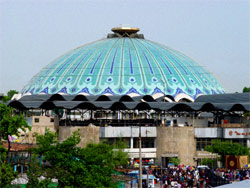 This bazaar is located in the very heart of so called Old Town of the capital, next to Chorsu square. Eski Juva has been operating at almost one and the same place for over two thousand years. Tashkent is known to be founded in the 2nd — 1st century B.C. in a fertile oasis to act as an important trade center at an intersection of the Great Silk caravan routes. Initially, there was a group of four small settlements which in later period formed four city’s districts: Beshagach, Shaikhantaur, Sebzar, and Kukcha. In the ancient times on a big vacant lot between these settlements there was set up a fair where local farmers, nomads and touring merchants exchanged their goods. For hundreds of years this place had become a crossroad of eastward, westward, southward and northward caravan routes used for carrying goods into and out of Tashkent. It was called Chorsu — ‘a crossroad’. You might find it interesting to know that some of the names of the streets in this area of Tashkent still remind about the directions of the Great Silk caravan roads: Samarkand-Darbaza («Samarkand Gate»‘), Chagatay (gate on the road to Chagatay), and so on.
This bazaar is located in the very heart of so called Old Town of the capital, next to Chorsu square. Eski Juva has been operating at almost one and the same place for over two thousand years. Tashkent is known to be founded in the 2nd — 1st century B.C. in a fertile oasis to act as an important trade center at an intersection of the Great Silk caravan routes. Initially, there was a group of four small settlements which in later period formed four city’s districts: Beshagach, Shaikhantaur, Sebzar, and Kukcha. In the ancient times on a big vacant lot between these settlements there was set up a fair where local farmers, nomads and touring merchants exchanged their goods. For hundreds of years this place had become a crossroad of eastward, westward, southward and northward caravan routes used for carrying goods into and out of Tashkent. It was called Chorsu — ‘a crossroad’. You might find it interesting to know that some of the names of the streets in this area of Tashkent still remind about the directions of the Great Silk caravan roads: Samarkand-Darbaza («Samarkand Gate»‘), Chagatay (gate on the road to Chagatay), and so on.
Tashkent repeatedly experienced enemy attacks: it was destroyed by the Arabs in the 8th century, burnt down by order of the ruler of Khorezm in the 13th century, conquered by Kokand khan at the beginning of the 19th century. But despite of all these events the bazaar went on functioning. In the 19th century near the bazaar there was built a citadel with turrets, one of which was used as an arsenal. This building gave name to the bazaar itself: Eski Juva («Old Tower»).
An oriental bazaar is not only a market place but also a kind of a club where one can meet friends and acquaintances; it is a public entertainment center, a place where news is spread by word of mouth. No wonder it gave life to the well-known expression uzun kulak (‘long ear’). Over here hurry those who love mixing with crowds, who enjoy the flavour of the Orient. In the East a bazaar also acts as a barometer of social life: while the shops dukans are open — everything is all right, if only they close at untimely hour a disorder is likely to happen.
The fact that Eski Juva bazaar was built in close vicinity of majestic Friday Jami Mosque and the Kukeldash Madrassah, dating back to the 15th — 16th centuries, is the evidence of its peculiar role as centre of the city’s social life.
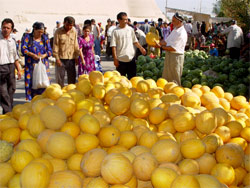 In the 1980s Eski Juva was reconstructed. Today the stalls of the ancient bazaar stand under seven huge domes covered with colored glazed tiles. As you enter the biggest domed building, a cloud of spice aromas envelopes you. What abundance! There is saffron and brown tree bark, red and black pepper, thyme and cloves, nutmeg, cardamom… — over 60 various spices and cooking herbs. Next to them are sacks with rice, sparkling crystals of navat sugar, and white balls of kurt — dried cottage cheese. Vying with each other, salesmen loudly offer raisins and dried apricots, almonds and pistachios, walnuts and peanuts. Here you can buy a special national dainty: peanuts boiled in sugar or honey and covered with sesame seeds.
In the 1980s Eski Juva was reconstructed. Today the stalls of the ancient bazaar stand under seven huge domes covered with colored glazed tiles. As you enter the biggest domed building, a cloud of spice aromas envelopes you. What abundance! There is saffron and brown tree bark, red and black pepper, thyme and cloves, nutmeg, cardamom… — over 60 various spices and cooking herbs. Next to them are sacks with rice, sparkling crystals of navat sugar, and white balls of kurt — dried cottage cheese. Vying with each other, salesmen loudly offer raisins and dried apricots, almonds and pistachios, walnuts and peanuts. Here you can buy a special national dainty: peanuts boiled in sugar or honey and covered with sesame seeds.
At all seasons the fruit and vegetable stalls impress with an abundance and diversity of the produce. But in summer and autumn the oriental bazaar is particularly impressing. What has been through hard work grown by Uzbek farmers is now on offer: rosy apples and honeydew pears; bunches of black, pink and amber sweet grapes; smooth and slightly furry peaches; prunes, and yellow figs placed on green leaves; pomegranates with ruby seeds; reddish-orange persimmons… Impressive are the piles of huge water-melons and melons which exhale pineapple aroma.
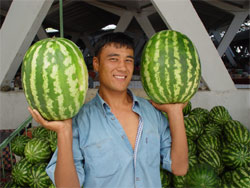 Everywhere at the bazaar there are heard the greetings exchanged by salespeople, shoppers or just acquaintances coming across each other: Assalom aleykum! «Yakhshimisiz?» («Hello! How are you?»). The salespeople try to attract shoppers, asserting: «Over here are the cheapest grapes!», «My peaches are sweeter!» If a shopper, on asking the price, immediately walks away from the salesman to another one, the former might get offended: ‘Brother! Why don’t you bargain? It’s the bazaar!’ Bargaining can really help to considerably reduce the price.
Everywhere at the bazaar there are heard the greetings exchanged by salespeople, shoppers or just acquaintances coming across each other: Assalom aleykum! «Yakhshimisiz?» («Hello! How are you?»). The salespeople try to attract shoppers, asserting: «Over here are the cheapest grapes!», «My peaches are sweeter!» If a shopper, on asking the price, immediately walks away from the salesman to another one, the former might get offended: ‘Brother! Why don’t you bargain? It’s the bazaar!’ Bargaining can really help to considerably reduce the price.
 At Eski Juva there is also a row of workshops under small domes. Inside them craftsmen make and immediately sell their works: jewelry and the painted cradles beshik; gold embroidery; national chests with metal decoration; embroidered suzanes (thin tapestries) and jiyak — lace for trimming the lower edges of women’s wide trousers; quilted men’s caftans chapan and women’s yashmaks; motley kurpacha quilts and pichok knives in leather or brass sheaths; wicker baskets and trays of various sizes and designs; national musical instruments. There are also workshops of whitesmiths and blacksmiths, carpenters and wood-carvers. Potters offer lyagan dishes and kosa bowls with blue and turquoise painted patterns. In the carpet row you can see carpets from Khiva, Samarkand, Bukhara, Afghanistan, Turkey, and even Belgium — and you cannot help remembering that you are in the very heart of the Silk Road trade.
At Eski Juva there is also a row of workshops under small domes. Inside them craftsmen make and immediately sell their works: jewelry and the painted cradles beshik; gold embroidery; national chests with metal decoration; embroidered suzanes (thin tapestries) and jiyak — lace for trimming the lower edges of women’s wide trousers; quilted men’s caftans chapan and women’s yashmaks; motley kurpacha quilts and pichok knives in leather or brass sheaths; wicker baskets and trays of various sizes and designs; national musical instruments. There are also workshops of whitesmiths and blacksmiths, carpenters and wood-carvers. Potters offer lyagan dishes and kosa bowls with blue and turquoise painted patterns. In the carpet row you can see carpets from Khiva, Samarkand, Bukhara, Afghanistan, Turkey, and even Belgium — and you cannot help remembering that you are in the very heart of the Silk Road trade.
Today’s bazaars in Uzbekistan are quite different from what they were like just 15 — 20 years ago. Realizing that bazaars play an important role in the trading system, Uzbek government adopted a program of reconstruction of the existing bazaars and construction of new ones in the capital and in the provinces soon after the country had become independent. The program has been successfully implemented. The residents and guests of Tashkent can now appreciate the reconstructed bazaars Eski Juva, Oloy Bozori, Mirobod Bozori, Yunusobod Bozori, Parkent Bozori and others. Their vast trading grounds are now in excellent condition; they are protected from sun and precipitation by domes. Many new stalls now appear under the huge shelters and in spacious pavilions. The bazaars are equipped with powerful refrigerators, storage areas, small-scale mechanisms; good sanitary service is available.
In the past the local farmers used to bring their produce on camels and donkeys, so near bazaar trading grounds there used to be caravanserais for people and fenced with earthen barrier corrals for animals. Today salespeople and shoppers come to bazaars by car. Therefore there have been built guarded parking lots and hotels at all the bazaars.
 Located in the center of Tashkent, Oloy Bozori was set up 150 years ago in New Town. It is the most up-to-date, equipped and advanced bazaar in the city. Standing under the huge shelter, the bazaar’s rows of stalls appear to stretch away as far as the eye can see. At this bazaar they offer only first-class produce. Oloy Bozori trades exclusively choice fruit and vegetables. As you walk along the row, you most likely find no crumpled tomato or the one with a dint, no wilted cucumber. The bazaar will impress you with abundance of high-quality produce. The products that sells at Oloy Bozory are practically the same as those you can find at other bazaars. But Oloy Bozori still has its peculiarities. It is only here that you can buy all sorts of meat and poultry, including turkeys, geese and ducks; agaric and oyster mushrooms grown in greenhouses; Caspian sturgeon and Far Eastern salmon. And moreover, this bazaar is the only place where it is possible to buy a bunch of birch twigs with leaves for whipping massage in Russian sauna Oloy Bozori is probably the least noisy and bustling bazaar in the city: it maintains its VIP status. The shoppers here are certainly friendly, but not meddlesome, without much pushing into purchase. Most likely none of the salespeople will loudly promote his produce and urge you to buy it if you start examining and choosing. You might find it a bit disappointing taking into consideration the traditions of an oriental bazaar. But there are other bazaars full of this trading exotics. Oloy Bozori, however, boasts cleanness, order, convenient location and handy sales arrangements.
Located in the center of Tashkent, Oloy Bozori was set up 150 years ago in New Town. It is the most up-to-date, equipped and advanced bazaar in the city. Standing under the huge shelter, the bazaar’s rows of stalls appear to stretch away as far as the eye can see. At this bazaar they offer only first-class produce. Oloy Bozori trades exclusively choice fruit and vegetables. As you walk along the row, you most likely find no crumpled tomato or the one with a dint, no wilted cucumber. The bazaar will impress you with abundance of high-quality produce. The products that sells at Oloy Bozory are practically the same as those you can find at other bazaars. But Oloy Bozori still has its peculiarities. It is only here that you can buy all sorts of meat and poultry, including turkeys, geese and ducks; agaric and oyster mushrooms grown in greenhouses; Caspian sturgeon and Far Eastern salmon. And moreover, this bazaar is the only place where it is possible to buy a bunch of birch twigs with leaves for whipping massage in Russian sauna Oloy Bozori is probably the least noisy and bustling bazaar in the city: it maintains its VIP status. The shoppers here are certainly friendly, but not meddlesome, without much pushing into purchase. Most likely none of the salespeople will loudly promote his produce and urge you to buy it if you start examining and choosing. You might find it a bit disappointing taking into consideration the traditions of an oriental bazaar. But there are other bazaars full of this trading exotics. Oloy Bozori, however, boasts cleanness, order, convenient location and handy sales arrangements.
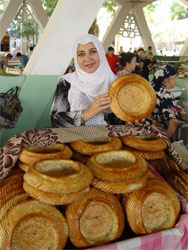 Founded in the middle of the 1st millennium B.C., Samarkand is one of the oldest Central Asian cities. For centuries it was a center of culture, science and crafts. But first of all it was a center of trade at a crossroads of the very important caravan roads from China, India, Iran, Russia and many other countries. In Asia trade had always been considered an occupation that pleases God; most of the rulers had taken a great care of it. In his travelogue «To the court of Temur at Samarkand» Ruy Gonzales de Clavijo, ambassador of the Castilian king, wrote that Temur ordered to built a vaulted roof over the main street of Samarkand and to set up tents for salespeople under it. In 1404, at the end of Temur’s rule, there was built a huge Friday mosque in Samarkand, the Bibi-Khanym Mosque (Bibi-Khanym was the Temur’s senior wife). Next to the walls of the mosque there appeared a bazaar. This bazaar has been swarming with people for five centuries since then; it is one of the oldest Central Asian bazaars.
Founded in the middle of the 1st millennium B.C., Samarkand is one of the oldest Central Asian cities. For centuries it was a center of culture, science and crafts. But first of all it was a center of trade at a crossroads of the very important caravan roads from China, India, Iran, Russia and many other countries. In Asia trade had always been considered an occupation that pleases God; most of the rulers had taken a great care of it. In his travelogue «To the court of Temur at Samarkand» Ruy Gonzales de Clavijo, ambassador of the Castilian king, wrote that Temur ordered to built a vaulted roof over the main street of Samarkand and to set up tents for salespeople under it. In 1404, at the end of Temur’s rule, there was built a huge Friday mosque in Samarkand, the Bibi-Khanym Mosque (Bibi-Khanym was the Temur’s senior wife). Next to the walls of the mosque there appeared a bazaar. This bazaar has been swarming with people for five centuries since then; it is one of the oldest Central Asian bazaars. The bazaar’s active life starts early in the morning and ends when it gets dark. The unique atmosphere of the oriental bazaar is created by inviting shouts of the salespeople, automobile honks, sounds of national music, smells of spices and roasted meat, fruit and vegetables of all colors… Here you can taste salty apricot stones baked in ashes, buy the famous round Samarkand bread — puffy, with golden crust. In the families of Samarkand bakers the art of making this unique bread has been passed down from generation to generation. Many tourists buy this bread as a souvenir: it remains beautiful and delicious for a long time. The round Samarkand bread is baked in a big clay oven called tandyr. There are a lot of types of this bread: big festive shirmon-non, rich patyr-non, hard yopkan-non to a special taste; very flat ones, with fancy patterns round the edge, covered with caravay-seeds or poppy-seeds, flaky, unleavened, with onions and greens… A guest to an Uzbek home will be first of all offered a small bowl of green tea and this traditional round bread.
The bazaar’s active life starts early in the morning and ends when it gets dark. The unique atmosphere of the oriental bazaar is created by inviting shouts of the salespeople, automobile honks, sounds of national music, smells of spices and roasted meat, fruit and vegetables of all colors… Here you can taste salty apricot stones baked in ashes, buy the famous round Samarkand bread — puffy, with golden crust. In the families of Samarkand bakers the art of making this unique bread has been passed down from generation to generation. Many tourists buy this bread as a souvenir: it remains beautiful and delicious for a long time. The round Samarkand bread is baked in a big clay oven called tandyr. There are a lot of types of this bread: big festive shirmon-non, rich patyr-non, hard yopkan-non to a special taste; very flat ones, with fancy patterns round the edge, covered with caravay-seeds or poppy-seeds, flaky, unleavened, with onions and greens… A guest to an Uzbek home will be first of all offered a small bowl of green tea and this traditional round bread.
In Temur’s time one of his wives, the queen Tuman-Aka, built a roofed headgear market in Registan Square, at an intersection of six roads. In 1420 the market was dismantled and replaced by the Ulugbek Madrasah. In 1845, close to it, next to Sher Dor Madrassah, there appeared a large domed shopping center called Chorsu (built with the bricks from the ruins of the Bibi-Khanym Mosque). The Swiss traveler Ella Mayar who visited Samarkand early in the 1930s wrote that as a European woman she was impressed by a mixture of so many different things sold there: scull-caps, soap, tobacco, braids, textiles, silk scarves, stockings, ribbons, thick pancakes on frying pans, chunks of mutton on big trays, sparkling crystals of navat sugar… Today Chorsu is a trading exhibition hall where you can buy Samarkand craftsmen’s works.
In the old times, on a certain day once a week there used to be held trade fairs in Asian countries. Some towns and villages were even named after those «market» days: the name of the Tajikistan’s capital Dushanbe means «Monday», a small town Juma near Samarkand is «Friday». The tradition of the weekly bazaars has been maintained to the present day. One of the most well-known of such bazaars is the one held on Sundays in the ancient town Urgut, 60 kilometers from Samarkand.
Urgut is really a town of craftsmen. There live hereditary blacksmiths, potters and embroiderers. On Sundays at this bazaar you can buy modern and traditional Urgut embroideries, silver jewelry with carnelians, tapestries and carpets, traditional clothes, handmade silk and cotton textiles, and many other exotic things.
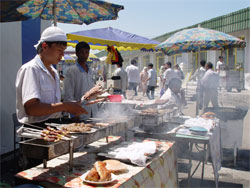 The bazaars in the historic part of Bukhara impress with their exotic character and an abundance of merchandise. At the beginning of the 20th century the American geologist and orientalist Rafael Pompelli left us the following notes: «The nature of huge Bukhara bazaar makes it the most «oriental» of all the bazaars: its narrow passages are protected from the sun with latticed roof; each type of goods is sold in a certain quarter of the city. Bukhara is famous for its unique arts and crafts: peculiar only to Bukhara are its silk textiles of exquisite colors and texture, carpets with amazing patterns, gold-embroideries and jewelry. We had bought a lot of things here, and yet later we were sorry we had not bought more.» In Bukhara there have remained intact a few shopping passages under 16-century domed roofs. And they are still used for trading! The passages lie at the crossroads of the streets Toki-Zargaron («Jewelers Dome»), Telpak-Furushon («Headgear Salespeople’s Dome») and Toki-Saraffon («Money-changers’ Dome»). These names themselves explain what trades the residents of these streets were initially engaged in.
The bazaars in the historic part of Bukhara impress with their exotic character and an abundance of merchandise. At the beginning of the 20th century the American geologist and orientalist Rafael Pompelli left us the following notes: «The nature of huge Bukhara bazaar makes it the most «oriental» of all the bazaars: its narrow passages are protected from the sun with latticed roof; each type of goods is sold in a certain quarter of the city. Bukhara is famous for its unique arts and crafts: peculiar only to Bukhara are its silk textiles of exquisite colors and texture, carpets with amazing patterns, gold-embroideries and jewelry. We had bought a lot of things here, and yet later we were sorry we had not bought more.» In Bukhara there have remained intact a few shopping passages under 16-century domed roofs. And they are still used for trading! The passages lie at the crossroads of the streets Toki-Zargaron («Jewelers Dome»), Telpak-Furushon («Headgear Salespeople’s Dome») and Toki-Saraffon («Money-changers’ Dome»). These names themselves explain what trades the residents of these streets were initially engaged in.
Today at the modernized Bukhara bazaars they sell not only the local handicrafts and agricultural products but also what has been grown in the neighboring provinces.
With the words Khush kelibsiz! — Welcome! — the bazaars of Uzbekistan open their gates and meet the guests with abundance of exotic marvels.
